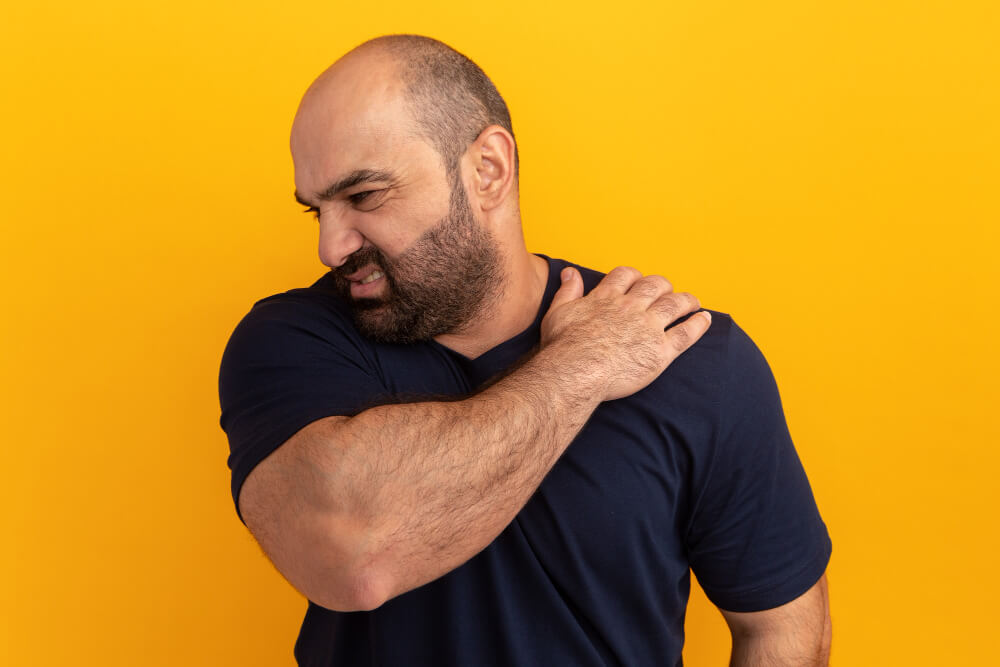Shoulder Pain? Taking Back Control with Treatment Options
Shoulder pain is a frustrating and common issue, limiting your ability to perform everyday activities and enjoy life. Whether it’s a sharp ache or a dull throb, shoulder discomfort can significantly impact your well-being. This article delves into the world of shoulder pain, exploring both surgical and non-surgical treatment options to empower you to regain control and return to pain-free movement.

Understanding the Source of Shoulder Pain
The shoulder is a complex joint with a wide range of motion. This flexibility comes at the cost of vulnerability to injuries and wear-and-tear. Common causes of shoulder pain include:
- Rotator Cuff Issues: The rotator cuff is a group of muscles and tendons that stabilize the shoulder joint. Tears, inflammation (tendinitis), or impingement can cause significant pain and weakness.
- Arthritis: Osteoarthritis, a degenerative condition, and rheumatoid arthritis, an autoimmune disease, can affect the shoulder joint, causing pain, stiffness, and swelling.
- Bursitis: Bursae are fluid-filled sacs that cushion the shoulder joint. Inflammation of a bursa (bursitis) can lead to localized pain and tenderness.
- Labral Tear: The labrum is a ring of cartilage that surrounds the shoulder socket. A tear in the labrum can cause pain, instability, and clicking sensations.
- Fractures: A fall or direct impact can fracture the bones of the shoulder joint, resulting in severe pain, swelling, and bruising.
- Dislocations: When the ball of the upper arm bone pops out of the socket, it causes a shoulder dislocation, leading to intense pain, deformity, and instability.
- Overuse Injuries: Repetitive overhead activities in sports or work can lead to overuse injuries, causing pain and inflammation in the muscles and tendons.
Non-Surgical Treatment Options for Shoulder Pain
Fortunately, most shoulder pain can be effectively managed with non-surgical methods. Here are some common approaches:
- Rest and Activity Modification: Avoiding activities that aggravate the pain allows for healing and inflammation reduction.
- Pain Medication: Over-the-counter pain relievers like ibuprofen or acetaminophen can help manage discomfort. Your doctor may prescribe stronger medications for severe pain.
- Physical Therapy: Physical therapy plays a crucial role in strengthening the muscles around the shoulder joint, improving flexibility, and restoring proper mechanics for pain relief and preventing future injuries.
- Ice and Heat Therapy: Applying ice packs to the affected area for 15-20 minutes at a time can reduce inflammation and pain. Heat therapy, such as a warm compress or bath, can help relax muscles and improve stiffness.
- Corticosteroid Injections: Corticosteroid injections, administered by a doctor, are powerful anti-inflammatory medications that can provide targeted pain relief in the joint or around the tendons.
- Bracing and Immobilization: In some cases, wearing a sling or brace can help immobilize the shoulder, promoting healing and reducing pain during the acute phase.
Deciding if Shoulder Surgery is Right for You
Non-surgical treatments are often the first line of defense. However, if pain persists despite conservative measures, your doctor might recommend surgery. Here are some factors to consider when deciding if surgery is right for you:
- Severity of Pain: If pain significantly interferes with your daily activities and sleep, and doesn’t respond to non-surgical treatments, surgery might be an option.
- Type of Injury: Certain conditions, like a severe rotator cuff tear or a displaced fracture, might require surgery for optimal healing and restoration of function.
- Length of Time in Pain: Chronic pain that lasts for months despite appropriate conservative therapy might be a reason to explore surgical options.
- Functional Limitations: If shoulder pain significantly limits your ability to work, participate in activities, or perform self-care tasks, surgery can improve your quality of life.
Common Shoulder Surgery Procedures

Different surgical techniques address specific shoulder problems. Here’s an overview of some common procedures:
- Arthroscopy: This minimally invasive surgery uses a small camera and specialized instruments to diagnose and treat shoulder problems. It allows for visualization and repair of torn rotator cuffs, labral tears, and removal of inflamed tissue.
- Rotator Cuff Repair: This procedure involves suturing a torn rotator cuff tendon back to the bone. It can be performed arthroscopically or with a larger open incision depending on the tear.
- Shoulder Replacement: In cases of severe arthritis or a damaged joint, a shoulder replacement surgery can replace the joint with an artificial prosthesis. Two main types exist: total shoulder replacement and shoulder resurfacing.
- Shoulder Instability Surgery: For recurrent shoulder dislocations, surgery can tighten ligaments and repair the capsule surrounding the joint to improve stability.
- Acromioplasty: This procedure involves shaving down a portion of the acromion bone, which sits above the shoulder joint. It can help create more space for the rotator cuff tendons, reducing impingement and pain.
Recovery and Rehabilitation after Shoulder Surgery
Following shoulder surgery, a successful recovery hinges on following your doctor’s instructions and participating in a dedicated physical therapy program. Rehabilitation typically involves:
- Pain Management: Medications and techniques like ice therapy can help manage post-surgical pain.
- Gradual Strengthening Exercises: A physical therapist will design a customized exercise program to gradually strengthen the muscles around the shoulder joint and improve range of motion. These exercises are crucial for regaining function and preventing future injuries.
- Balance and Coordination Training: Restoring balance and coordination in the shoulder joint is essential for safe movement and preventing falls.
- Scar Tissue Management: Scar tissue formation is a natural part of healing, but it can sometimes restrict movement. Physical therapists use techniques like massage and stretching to minimize scar tissue and maintain flexibility.
The recovery timeline varies depending on the type of surgery and the individual’s healing process. Simple arthroscopic procedures might allow for a quicker return to daily activities within a few weeks, while major surgeries like shoulder replacement might require several months of rehabilitation.
Living Well After Shoulder Surgery
Following a successful shoulder surgery and dedicated rehabilitation, most individuals experience significant improvement in their pain levels and regain a greater range of motion. This translates to a better quality of life, allowing you to resume activities you previously enjoyed, such as sports, hobbies, and spending time with loved ones. However, it’s important to maintain healthy habits to promote long-term joint health:
- Maintaining Good Posture: Proper posture reduces stress on the shoulder joint.
- Maintaining a Healthy Weight: Excess weight puts additional strain on the joints.
- Warm-Up and Cool-Down Exercises: Before participating in physical activities, perform light stretching and warm-up exercises to prepare the muscles. Similarly, cool down with gentle stretches after workouts.
- Listening to Your Body: Avoid activities that cause pain and be mindful of limitations.
Conclusion
Shoulder pain can be a significant obstacle to living a fulfilling life. Fortunately, with a variety of treatment options available, regaining control and achieving pain relief is possible. By working closely with your doctor and physical therapist, you can navigate the path toward a stronger, more functional shoulder, allowing you to return to the activities you love. Remember, early diagnosis and intervention are key to achieving optimal results. If you’re experiencing shoulder pain, consult with a healthcare professional to explore the best course of action for you.
